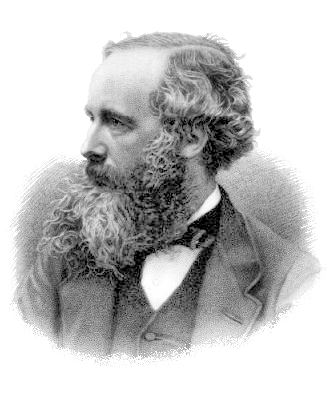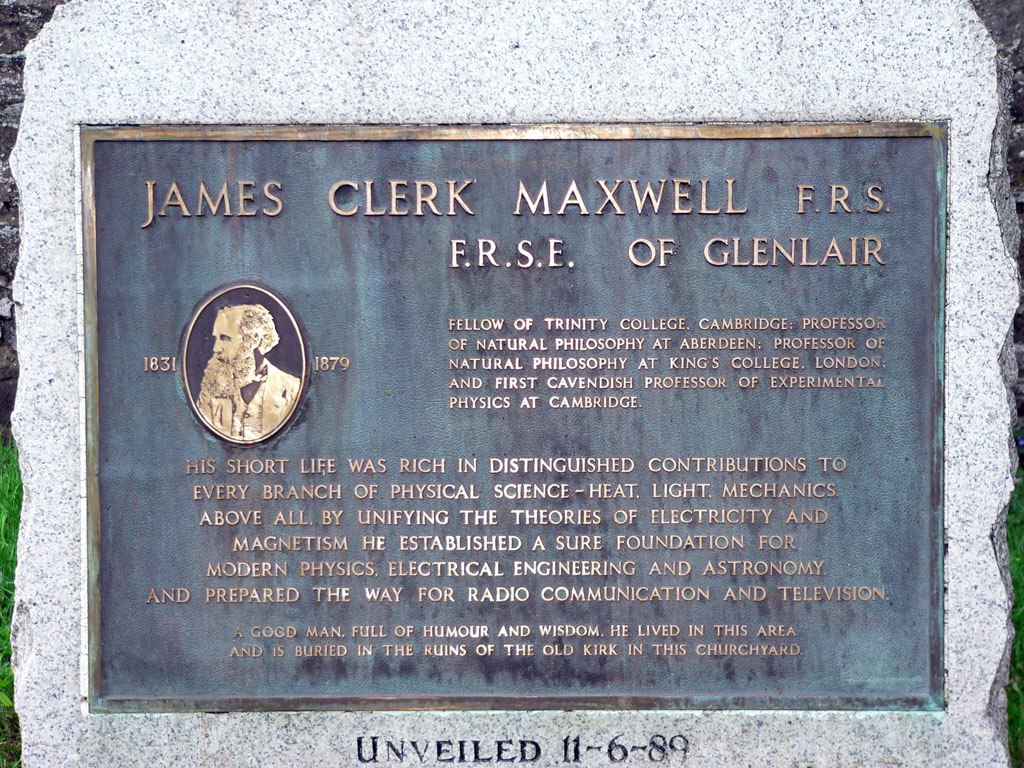Clan Maxwell Society
Celebrating the Scottish Heritage of Maxwells and their Allied Families
Adair • Blackstock • Dinwiddie/Dinwoodie/Dinswoodie • Edgar • Herries • Kirl • Kirkland • Latimore/Latimer • MacKittrick • Maxton • Monreith • Moss • Nithsdale • Peacock • Pollock/Pollok • Polk/Paulk • Rawlins • Sturgeon • Wardlaw
JAMES CLERK MAXWELL
1831 — 1879


There are a few names which stand out above all others in the history of mathematics and science, names such as Einstein and Newton — and Maxwell.
Though perhaps not quite as familiar to the average person as Einstein or Newton, James Clerk Maxwell’s contributions to science affect each of us every day. His theory of electromagnetic radiation opened the door for the use of radio waves for radio, television, and countless other modern applications. His “Maxwell’s law” is considered one of the ten mathematical formulas which changed the face of the earth. His genius paved the way for Einstein to determine the connection between Energy, Mass and the speed of light which is the fundamental structure of his Theory of Relativity and is at the core of the development of Atomic Energy as a released force. The list goes on and on, and his reputation even extends beyond our own planet, with a large area of Mars named “Maxwell” because his electromagnetic theories enabled the invention of the radio telescope which first photographed it.
James Clerk Maxwell was born in Edinburgh, and his family moved to Glenlair in Kirkcudbrightshire, near Dumfries, when he was just over two years old. Glenlair, on the west bank of the river Urr, was all that remained of an historic Maxwell property, the estate of Middlebie. That estate had become the property of the boy’s great-grandfather, George Clerk of Penicuik, son of the Laird of Dumcrieff, after he married Dorothea Maxwell in 1735. George assumed the name of Clerk Maxwell and became the fourth baronet of Penicuik.
At Glenlair, young James Clerk Maxwell enjoyed a country upbringing within an established and respected family. His parents planned to educate him at there until he was 13 and then send him to Edinburgh University; however, those plans changed when his mother died. A tutor was hired for the eight year-old, but the arrangement was not successful, and James was enrolled in the Edinburgh Academy.
Living at the home of his father’s sister, James entered Edinburgh Academy in 1841, where he earned the nickname ‘Dafty’ for his habit of drawing curious diagrams and making rude mechanical models. Though considered eccentric by some of his classmates, he distinguished himself as one of the most brilliant in his school, winning prizes for scholarship, mathematics, and English verse.
In 1846, James began going with his father to meetings of the Edinburgh Society of Arts and the Royal Society, where a practical problem being discussed was how to draw a perfect oval. The 14 year-old wrote a paper on the subject which was read to the Royal Society of Edinburgh which, while containing ideas not entirely new, was considered remarkable for one his age. Two years later, at the University of Edinburgh, he was excelling in mathematics and the physics classes to the extent that his teachers gave him free use of school labs for his original experiments. He wrote two valuable papers during that period on the Theory of Rolling Curves and the Equilibrium of Elastic Solids.
James Clerk Maxwell entered Cambridge in October 1850, first at Peterhouse College and then at Trinity College. Cambridge afforded him daily contact with intellectuals, both students and faculty, and he focused on philosophy and theology as well as the sciences. He graduated with a degree in mathematics in 1854, and then he remained at Cambridge where Trinity awarded him a Fellowship to continue his work.
It was during those Cambridge years that Maxwell unveiled one of his most important achievements, his extension and mathematical formulation of Michael Faraday’s theories of electricity and magnetic lines of force. His paper on the subject was read to the Cambridge Philosophical Society in two parts, in 1855 and 1856, showing that a few relatively simple mathematical equations could express the behavior of electric and magnetic fields and their interrelation.
In early 1856, he decided to return to Scotland to be nearer his ailing father. Though his father died in April of that year, he remained in Scotland, accepting an appointment to Marischal College in Aberdeen. When St. John’s College at Cambridge announced that the subject for the following year’s Adams Prize was “The Motion of Saturn’s Rings,” Maxwell decided to compete for the prize. His research concluded that stability could be achieved in Saturn’s rings only if the rings consisted of numerous small solid particles, an explanation confirmed about 140 years later by the Voyager spacecraft. Maxwell’s findings won him the Adams Prize and acclaim for making one of the most remarkable applications of mathematics to physics ever seen.
He married in 1858 to Katherine Mary Dewar, the daughter of the Principal of Marischal College. But despite that family connection, he had to seek a new post in 1860 when Marischal College and King’s College combined. His remarkable achievements made him a prime candidate for the Chair of Natural Philosophy at Edinburgh, but he lost out because communicating his ideas to other people was not his strongest point.
He did find an excellent position, however; in 1860, he was appointed to the chair of Natural Philosophy at King’s College in London. The six years Maxwell spent in that post were the years during which he did his most important experimental work. He calculated that the speed of propagation of an electromagnetic field is approximately that of the speed of light and proposed that the phenomenon of light is, therefore, an electromagnetic phenomenon. He also formulated a kinetic theory of gases which held that temperatures and heat involve only molecular movement, a theory which departed from the concept of certainty, in which heat was viewed as flowing from hot to cold, in preference to one of statistics, in which molecules at high temperature have only a high probability of moving toward those at low temperature.
Maxwell left King’s College, London, in the spring of 1865 and returned to his Glenlair estate in Scotland. There he did most of the work on the four partial differential equations which are now known as Maxwell’s equations, one of the great achievements of 19th Century mathematics. He returned to Cambridge periodically to lecture and, in 1871, reluctantly accepted an offer to return full time as the first Cavendish Professor of Physics. In that post, he designed and set up the Cavendish laboratory, named for English physicist and chemist Henry Cavendish whose experiments in the composition of air, the nature and properties of hydrogen, the specific heat of certain substances, the composition of water, and various properties of electricity had made him one of the most important scientists of his era. Under Maxwell’s guidance, the laboratory opened in 1874 and began its role as the site of the development of much of modern physics.
Between 1874 and 1879, Maxwell spent much of his time editing Henry Cavendish’s papers. Cavendish had published only two papers but left twenty packages of manuscript on mathematical and experimental electricity. Maxwell explored the earlier work thoroughly, repeating many of Cavendish’s experiments, and produced “The Electrical Researches of the Honourable Henry Cavendish” in 1879, a volume considered a cornerstone in the history of electricity.
Maxwell’s health began to fail during the spring of 1879, but he continued to give his lecture until he could return to Glenlair for the summer with his wife, who was also ill. Though his health continued to deteriorate, he returned to Cambridge the next fall, and it was there that James Clerk Maxwell died on November 5, 1879.
Almost 122 years after his death, James Clerk Maxwell is revered as one of history’s greatest scientists. Albert Einstein accorded him such importance that a picture of Maxwell was the only photograph in his office. Describing the Scot’s contributions to science, Einstein said, “One scientific epoch ended and another began with James Clerk Maxwell.” Many believe this quiet man of science, this Maxwell, to have had the greatest impact of anyone ever born on Scottish soil.
Copyright © 2001 — 2023 | All Rights Reserved | Maxwell Writers Group
Site design KWGraphicsandWeb